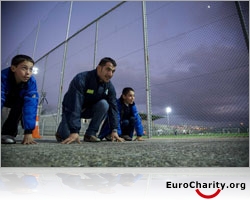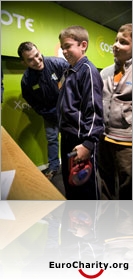For the first time the programme reaches 10 municipalities in Thessalia and Mainland Greece. An integrated view of the athletic abilities and dietary habits of young people, 9-16 years old, in Attica and the Greek periphery.
The Ergometric Programme “Join us in sports” visits the Greek periphery for the first time with the support of COSMOTE, the scientific support of the Ergophysiology – Ergometrics Laboratory of the Department of Physical Education & Sports Science of the University of Athens and the organisational support of the EF ZIN foundation.
The programme will visit ten towns of Mainland Greece and Thessalia, with first stop in Volos, aiming to help children and teenagers find the most suitable sport for them, and more importantly, make exercise part of their everyday life.
The Ergometric Programme was first launched in November 2006 and since then has visited 34 municipalities of Attica having assessed a total of 7, 976 children. It is the first time in Greece that data about the physical condition of this age group (9-16 years old) is collected using advanced technological devices and strict scientific methods. The expansion of the programme to Volos, Levadia, Amfissa, Lamia, Karpenisi, Karditsa, Larisa, Agrinio, Chalkida and Trikala will allow evaluating a large representative sample and will provide a valid and reliable assessment for the physical condition of youngsters in Attica and the Greek periphery, through comparative data.
Scientific results
Indicative findings from the 2008 evaluations in Attica include among others:
- Football and basketball are the most popular sports among boys, with 60% of participants engaged in them, while 10% are engaged in swimming
- Amonggirls, rates are spread between volleyball (~20%), swimming (~12%), basketball (~12%), track athletics (~11%), dance (~10%) and rhythmic/artistic gymnastics (~13%)
- A significant percentage of children (30%) are involved in sports requiring different levels of physical abilities than their own
- A significant percentage of children (20%) eat out 2-3 times per week
- A significant percentage of children do not have breakfast (~21%) and consume sweets and soft drinks on a daily basis (~30%)
Benefits
Participants receive a personal report with ergometric assessment results. The report describes their physical ability levels, based on Greek and international standards for specific ages, directing them to select the most suitable sport for them. Participants are also given information about their dietary habits and are encouraged to adopt healthy eating. The assessment results constitute a reliable source of information for parents about their children’s physical abilities and particular characteristics and bring to the light the importance of daily exercise and healthy eating adapted to the individual needs of the participants.
For yet another year, the programme is supported by weightlifting Olympic Champion and COSMOTE Corporate Social Responsibility Ambassador, Pyrros Dimas . As part of the programme Pyrros is visiting every town, encouraging children and youngsters to make sports part of everyday life.
Following the launch of the programme, COSMOTE Corporate Affairs Director Mrs. Marilena Fatsea stated: “After two successful years of the COSMOTE “Join us in Sports” Ergometric Programme in Athens, this year we are visiting Mainland Greece and Thessalia for the first time. Our aim is to promote sports and healthy dietary habits to youngsters of the Greek periphery and give them the opportunity to develop a balanced personality.”
For further information please call 210 994 4544, Monday to Friday from 10:00 to 14:00. Priority will be given to applications as they arrive.
What is the Ergometric Programme?
The Ergometric Programme is an educational sports-oriented programme for children 9-16 years old.
Ergometrics tests are being carried out in a specially designed mobile unit with advanced equipment by the University of Athens scientific personnel (ergophysiologists, PE instructors, dieticians). The programme includes speed, stamina, strength, lower limb sprinting, upper body strength and flexibility measurements along with bodymetrics specifications. Measurements assess children’s physical condition, examine their dietary habits and form a complete overview of the youngsters’ athletic skills and potential, according to the individual characteristics of each participant.


